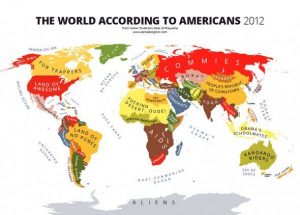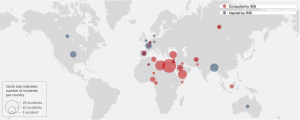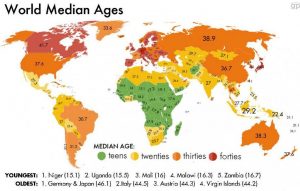Patrick Barry Dr. Barney
5th March 2021 The Rhetorical Lives of Maps
Blog Week #2

The Rocket Launch Sites[1] of the world map shows an overview of a varied array of launch sites around the globe and information pertaining to the amount of launches from each. Posted on Internet map forums by an amateur map enthusiast in 2015. It strives to illustrate how launch sites are placed in major countries and uses color coding and a key with explanations to convey information. The map is a standard Mercator projection of the world and gives special attention to the US and Russia, or as it was at the time the USSR.
The map like any map is fraught with positives and negatives in its bias whether conscious or unconscious and in the experience, it gives the viewer. The map labels spaceports that have flown a rocket more than 1,000,000kg with a gold star surrounded by a gold circle in the color corresponding to their total amount of launches. The choice of a star used to signify the heaviest rockets launched and most launches at these specifics sites shows a clear bias and social intent as the star while not directly indicated in the key carries with its societal preconceptions that influence the viewers opinion. Only Russia and America have the star. The star denotes excellence in a societal context and that context cannot be forgotten when looking at the map so by making this choice it lessens and fails to recognize the enormity of other countries achievements and frames the world in a Eurocentric nationalistic view. This affects how the viewer comes to know the world of international rocketry as though this map does show private space ports it does not label them so. There is no private entrepreneurial facilities category or elaboration on success rates of rockets launched, type of rocket technology used, market niche, or limitations of the launch site. It fails to even account for differences in facility scale and or the industries that support it. For instance, the launch site in New Zealand relates to a New Zealand based private space company[2] that specializes in small satellite launches. Whilst the Cape Canaveral base in Florida is run by a government military organization and focuses on issues akin to the national agenda. If not specified, the distinction between governmental and private is unknown. This is problematic as the two are quite different in that private ventures must strive to turn a profit while governments can pursue loftier, less lucrative goals.
The map for all the short comings of being too broad and vague and not showing the unique individuality of each site has its many positives. It gives a better picture of just how the space infrastructure is spread throughout the world in places one would not think it would exist such as Sweden, Kenya, and Peru. So, whilst the map does uphold a Euro American dichotomous view of the US and Russia being the major players it also challenges preconceptions that those are the only two. The map also shows the marks of history and change as many of the sites are defunct and some are going through a period of change or spurring other changes within their nation[3]. The sites do not exist within a bubble and interact with the industries, people, and governments of their nations. Especially when places like the Baikonur Cosmodrome which is operated by the Russians but lies within a different nation. The map shows multiple sites in India and China which outnumber the established sites in the west in number but not, yet quantity of rockets launched or tonnage, but that may change with time. The map raises this question in its function. The map is on one hand a depiction of the old known state of space but on the other hand a snapshot of the future where America might not lead the charge into the next frontier and questions the status quo. It is a factual map of the present but also a visual projection questioning the future of space as private or public led by current leaders or new challengers.
[1] wohVPpF.jpg (3000×1688) (imgur.com)
[2] Rocket Lab | Frequent and reliable access launch is now a reality | Rocket Lab (rocketlabusa.com)
[3] A Brief History of the Congolese Space Program | Mental Floss







